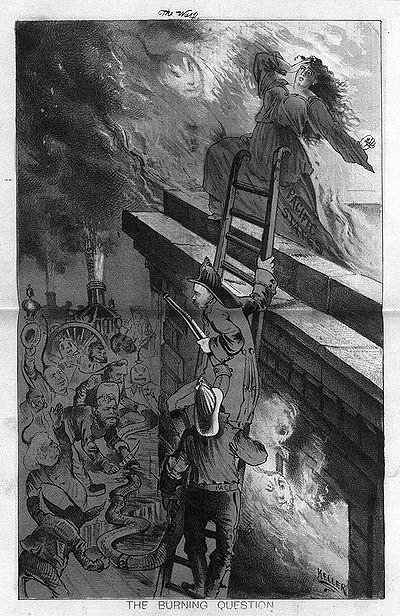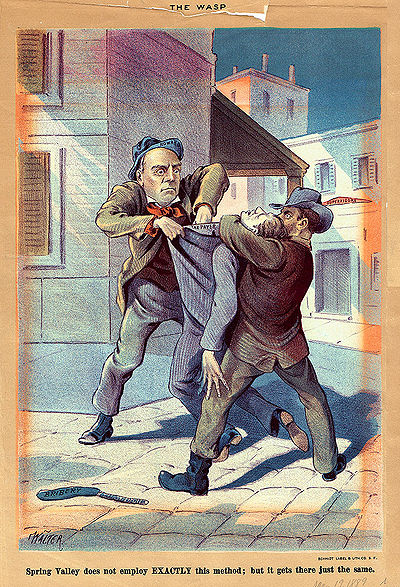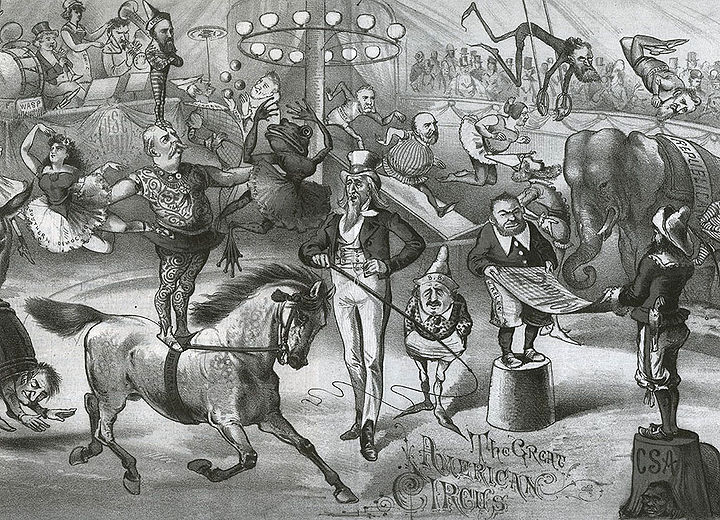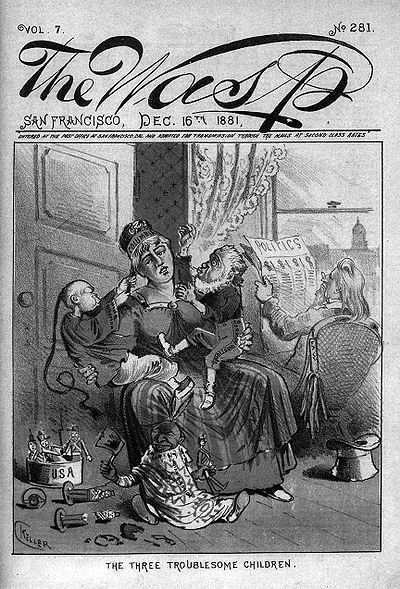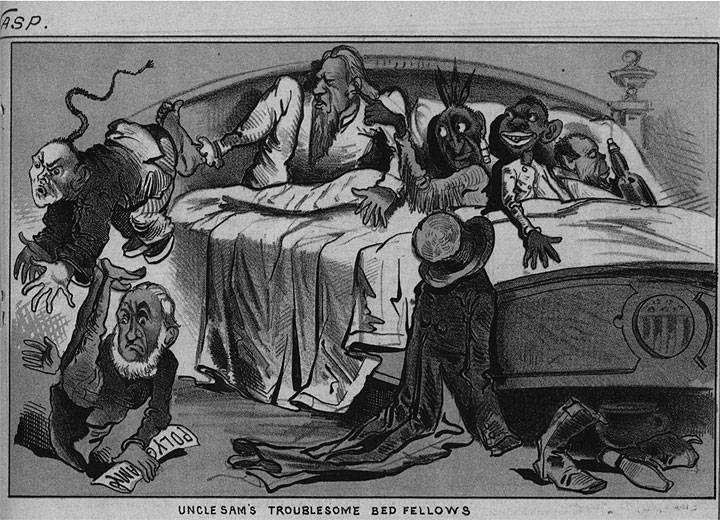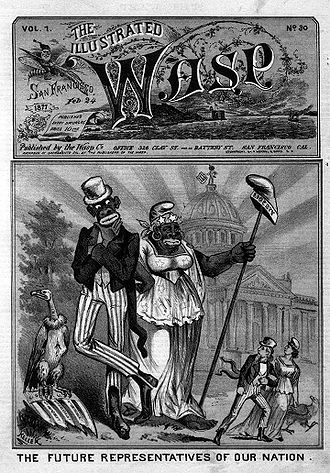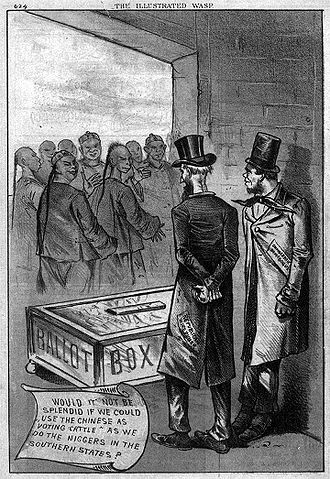WASP: Racism and Satire in the 19th Century
Historical Essay
by Nicholas Sean Hall
Originally published as The Wasp's "Troublesome Children": Culture, Satire, and the Anti-Chinese Movement in the American West in California History, Vol. 90, No. 2 (2013); excerpted with permission.
"The Burning Question", April 14, 1882
Image: Bancroft Library
The West Coast was going down in flames. Or at least that was how The San Francisco Illustrated Wasp depicted the region to its readership of middle- and working-class Anglo Americans in an April 1882 political cartoon. As Congress debated what would become the Chinese Exclusion Act a month later, the Wasp published a two-page chromolithograph entitled The Burning Question, one of a series of cartoons supporting the case for immigration restriction. The image put into caricature the cultural imagination of whites in the American West, who by the late 1870s had worked themselves into a frenzy over the putative cultural and economic threats posed by the "Chinese menace." In the late 1860s, the Democratic Party had rehabilitated its image—stained by the stigma of secession during the Civil War—on a platform of exclusion. Simultaneously, "anti-coolie" clubs held clandestine meetings to discuss ways to rid the Pacific Coast of its Chinese immigrants. Despite this opposition, these immigrants did have their allies in the West, particularly among Protestants and members of the Republican Party. Yet these allies too disappeared by the late 1870s as white political opinion solidified against the Chinese.
The period of radical Reconstruction in the five years following the Civil War had heralded potentially revolutionary implications for race in America, particularly the Thirteenth, Fourteenth, and Fifteenth Amendments to the United States Constitution, all adopted by 1870. That moment, however, did not last. With the federal government in full retreat from this racially egalitarian period—illustrated most notably in its concession of "home rule," including the restoration of white supremacy, to the South in the Great Compromise of 1877—nearly all whites in California began clamoring for the federal government to also address its racial "problem." Entreaties from the state's representatives in Congress to bar the Chinese from immigrating to the United States became louder and more agitated. Californians, however, would be thwarted by the presidential veto pen until the inauguration of restriction-friendly Chester A. Arthur in 1881.(1)
The final push by western congressional representatives to close the gate to the Chinese came in the spring of 1882. Like many other elements of western popular culture produced during this period-books, magazines, plays, broadsides, paintings, and the like—the Wasp reflected the West's growing impatience with federal inaction. As the congressional vote neared, the satirical weekly produced "yellow peril" cartoons vilifying Chinese immigrants at increasingly shorter intervals. In The Burning Question, a damsel in distress ("Pacific States") screams for help atop a burning building. A caricature of a disembodied "Chinese. menace" looms threateningly in the sky above her. Firefighters rush to the scene with a fire hose ("Anti Chinese Bill"), but several men with knives and queues attempt to cut off the water supply.(2) Would the federal government save the western states?
The Wasp’s cartoons provide numerous visual cues that made its political messages effective, putting into sharp relief the anti-Chinese crusade as seen through the eyes of politically moderate whites in the Far West. They also represent a critical historical component of the anti-Chinese movement in late-1870s California—an unstudied element of western popular culture that served as both a mouthpiece for western social issues and a critic of local and national figures it deemed hypocrites.(3) Close examination of the weekly's cartoons reveals the publication's shifting—and at times contradictory—stance on the people and issues of its day. They suggest its determination to integrate California into the national politics of race at a critical juncture in American history (the final collapse of Reconstruction in 1877) while taking on the daunting task of portraying a flawed California society in such a way that would not discourage whites in the eastern United States from immigrating to the West.
The Wasp achieved remarkable popularity in its late-nineteenth-century heyday, despite its relatively parochial circulation and the expense of publishing in the midst of the nineteenth century's deepest economic depression. Within months of its first issue, circulation grew to 5,000, reaching 7,000 by 1879. While most of its upstart rivals had collapsed within a year or two due to high production costs, the Wasp quickly became the most widely read magazine west of the Rocky Mountains.(4) As a voice of western anti-Chinese sentiment, it stood in contradistinction to earlier anti-Chinese violence—from Gold Rush pogroms to the well-publicized massacre of sixteen men, a woman, and a child in Los Angeles in 1871—as well as to more radical elements of the late 1870s, including the infamous Workingmen's Party of California (WPC).(5)
Place serves a key role in understanding the Wasp' s uniquely western portrayal of race and marginality. As scholars have shown, social and racial hierarchies tend to vary according to region; different social milieus contain their own contingent imperatives.(6) Social and political actors in late-1870s California still grappled with establishing the proper place for its myriad people, particularly but not exclusively its marginal groups. Wealthy railroad magnates, Irish laborers, Chinese immigrants, indigenous people, Mormons (who suffered under the stigma against polygamy, whether they took part in the practice or not), Mexicans, and a tiny African American minority composed the regional society of the nineteenth-century American West. Most of these groups, powerful and powerless, received their fair share of ridicule from the Wasp's artists and writers.(7)
The unlikely success of the Wasp stemmed from its biting social criticism, its irreverent attitude toward powerful figures, and its staff's keen sense of popular discontent with economic downturn, unemployment, and "problem groups." This does not discount, however, the quality of publication the Wasp gave its readers, particularly after the weekly mastered the creation of high-quality cartoon art complemented with sophisticated satire during its first year of publication. Once it found its wings, only Thomas Nast of Harper's Weekly in New York surpassed Wasp cartoonist G. Frederick Keller in the excellence of his caricature and wit.(8)
The Wasp meted out ridicule to a myriad of caricatured subjects, from senators and presidents to Chinese immigrants and Mormon polygamists. But how did these illustrations—the weekly's visual language—construct, reinforce, and/or subvert stereotyped images of the West's marginal groups and their most virulent opponents? How did the publication use mockery in its images to deploy messages about the putatively "proper" or "natural" place of groups within society, serving as the locus of criticism of and agitation for the Chinese exclusion crusade?
"Spring Valley [Water Co.] does not employ exactly this method, but it gets there just the same..." This is the kind of satire directed at local businessmen that also was a big part of The Wasp's content. This is directed at the local water monopoly
Image: Shaping San Francisco, from THE WASP, July 19, 1889
Building the Wasp’s Nest
When the first issue of the Wasp rolled off the presses on August 5. 1876, San Francisco had only one other illustrated periodical, the virulently anti-Catholic Thistleton's Illustrated Jolly Giant. Just before he published his first issue, Wasp owner and publisher Francis Korbel coaxed editor George Mackrett away from his rival to take charge of the new publication.(9) Korbel's initial foray into publishing did not feature, however, the colorful, biting wit or the full-color chromolithographs that would come to define the weekly in its prime. The latter appeared in stages: the first issues contained only black-and-white illustrations. Then, in December 1876, the Wasp began to run cartoons in black with a green background wash. The full three-color chromolithograph that became so popular during the Gilded Age made its debut nearly six months later, in the May 26, 1877 edition.(10)
Korbel, a Czech dissident, began publishing the Wasp sixteen years after his escape from the Austrian Empire. He fled to the United States in 1848, first to New York and then to San Francisco, the booming capital of the California Gold Rush. He sent for his brothers, Anton and Joseph, and by the early 1860s the reunited trio had established a business producing cigar boxes and labels. To identify particular brands, and to set their product apart from that of competitors, cigar-box makers relied on lithographed labels. The Korbels found an excellent man to produce their cigar-label lithographs in G. Frederick Keller, known at the time as an artist of structures and scenic views.(11)
When Korbel assigned Keller to work on the Wasp, the illustrator had to hastily learn to caricature the powerful and powerless. His first drawings hardly reflect the virtuosity and skill he later displayed.(12) Also an immigrant, Keller had arrived from Prussia in the late 1860s to apprentice with the lithographer George Baker. Although the craft was new to him, Keller came into political cartooning at an opportune moment, when advances in lithography (a means of creating mass reproductions wherein an artist etched a drawing into wax before applying it to a lithographic plate, which then printed it on a blank page) made an easy transfer from the medium of cigar-box labels to political cartoons.(13)
Korbel's background deeply influenced the views he brought to the Wasp. His flight to the United States had all the earmarks of hyperbolic stories told by immigrants in mid-nineteenth-century San Francisco taverns. In 1848, the iron-fisted Prince Windiszcrec ordered Korbel arrested and imprisoned for taking part in a failed coup against his regime. According to the story, Korbel, wearing civilian clothes smuggled in by his grandmother, casually walked out through an unlocked gate, smoking a cigar (perhaps inspiring his initial business venture in California). Whatever pride Korbel felt in his immigrant story, however, seems never to have affected his views on the plight of Chinese immigrants in the West, at whom he took frequent aim in the pages of his weekly.(14)
To understand the Wasp requires a solid idea of the context in which Korbel conceived it. The same sense of justice that drove the publisher to plot against the Hapsburgs fed his growing distaste for the rampant corruption in urban political machines and the newly centralized federal state.(15) Not one to fear a challenge to injustice, Korbel established the Wasp to voice his grievances against government complicity with tyrannical railroad monopolies and unrestricted immigration from China. The publication took special aim at the owners of the Central Pacific Railroad, the local corporate giant, as the source of both threats. The Wasp fit well with San Francisco, one of the most racially and religiously diverse cities in North America, a place where irreverence and creativity found ample reward. In this milieu, the mockery of its editorial cartoons received a welcome reception.
Having naturalized after the Civil War and now free to exercise his American right to free speech, Korbel seized his opportunity to create a mouthpiece for his views on American soil. In 1876, he produced an illustrated periodical filled with political cartoons that skewered Republican presidential candidate Rutherford B. Hayes and praised his Democratic challenger, Samuel Tilden. To Korbel, Tilden represented the antithesis of everything for which President Ulysses S. Grant stood. While the Grant administration remained mired in scandal and corruption for its duration, Tilden, as governor of New York, had brought the Tweed and Canal Rings to justice. Korbel's enthusiasm for Tilden's campaign likewise motivated Keller; as the election neared, he began to show the first signs of his vicious style of ridicule that would set him apart from the lion's share of his contemporaries.(16)
The disparity between the popular and electoral votes in the 1876 presidential election and the equally infamous Hayes-Tilden Compromise of 1877—granting the Republican Party the presidency in exchange for the removal of all federal soldiers from the South—left Korbel disenchanted with partisan politics, and his weekly soon dropped the Democratic cause. However, the publication continued to take contradictory political stances. Following its initial phase as a Democratic vehicle, the Wasp vacillated between independent and Republican positions before abandoning political endorsement entirely—a position it would hold throughout the next four years.(17) Until the passage of the Chinese Exclusion Act in 1882, the weekly maintained a nonpolitical stance, selecting its targets from a broad political and social spectrum.
That national politics initially motivated Korbel to publish a politically oriented journal suggests that while the Wasp may have covered its fair share of local or western issues, it was aware of its place in a larger national context. Its cartoonists and editors read sister illustrated weeklies from the East Coast. As it did with other Bay Area publications, the Wasp borrowed material from Joseph Keppler's New York-based illustrated weekly, Puck. Although Puck had a wider readership in a much more populated region of the nation, the quality of the Wasp’s illustrations and satire effectively made it Puck’s West Coast counterpart.(18)
The Great American Circus, October 23, 1880 (detail)
Image: California Historical Society; CHS2013.1169
During the 1880 presidential race, the Wasp ran The Great American Circus. Instead of the hard-and-fast partisanship of the previous presidential election, the cartoon spotlights the Wasp’s new nonpartisan political stance by portraying all politicians as members of a circus show. Uncle Sam, one of Keller's favorite cartoon tropes, serves as ringmaster to the key players—leading political candidates—in the circus's center ring. In the background on the right is the Republican platform, replete with the party's elephant symbol (originally created by Nast for the 1874 elections). In front of it, Democratic New York City comptroller John Kelly and "Johnny Reb" (standing on a pedestal labeled "CSA," Confederate States of America) hold a banner promoting the November 2, 1880 election. In the background on the left, the Wasp joins Chic (a short-lived New York satirical weekly), Puck, and Harper's Weekly as players in the circus band—a self-congratulatory gesture highlighting the Wasp’s critical role in the "circus" of American politics. The cartoon implies that the Wasp and its East Coast illustrated contemporaries set the tune to which national politicians "performed" for the electorate.(19)
Keller shows equal disdain for the Democrats. In the foreground on the left (not pictured), a well dressed woman representing the wealthy rides on top of a Democratic jackass (a party icon since Andrew Jackson's 1828 presidential campaign). The animal rests upon the exploited poor, characterized by a man in a barrel with a dollar sign, who bears the burden of all those he carries. The message is clear: the Democrats duped the poor • into supporting a party that promoted the interests of the rich to the working class's own detriment. In front of these figures (pictured above), Democratic presidential candidate Winfield Scott Hancock performs a delicate act, tenuously standing atop a galloping horse while balancing his running mate, William Hayden English, on his head.
Such cartoons positioned the Wasp as part of a highly influential group of American satirical publications. They suggest the influence that the weekly believed it held among its contemporaries and its nearly 10,000 subscribers, emphasizing the publication's salience as a prominent cultural arbiter and source of social criticism in the American West.
Images of Marginality
Though racism, bigotry, and gross asymmetries of wealth existed in all American regions during the late nineteenth century, divisions of groups in the American West ran along many particular racial, ethnic, and religious lines. Unlike the South, where whites enforced the strict caste subordination of African Americans, the West's solutions were more opaque and difficult to implement. And while the Wasp’s cartoons conveyed messages about the place of marginal groups—particularly the Chinese—the weekly also took aim at local and national elites, from greedy San Francisco rail magnates to corrupt federal politicians, most commonly for exercising near-conspiratorial power, corruption, or gross managerial incompetence.
The Three Troublesome Children, December 16, 1881
Image: Bancroft Library
Two cartoons illustrate the Wasp’s grasp of these groups at the local and national levels. The first, The Three Troublesome Children, the December 1881 cover illustration, depicts marginal groups unique to the American West and their alleged threats.(20) In it, Keller represents Columbia—the female personification of the United States—as a maternal figure with three children. The coolie laborer ("China Question")—the unfree worker on a fixed contract sent by labor agents in China—pulls her hair as a bearded Mormon squirms on her lap and spits in her face.(21) Both the Chinese and Mormon characters are disdained for their anti-American inclinations—the former for their supposed disinterest in acculturating to American ways of life and the latter for their social insularity and open contempt for the federal government and its attempts to interfere with their ways. Utilizing a common artistic trope to denote marginality, Keller depicts figures of the "lowest" social groups toward the bottom of the cartoon. Here, the lowest is the American Indian, who destroys toy soldiers at Columbia's feet, suggesting the perceived threat of violence from indigenous peoples yet to be removed to reservations.(22)
The cartoon also conveys a palpable sense of frustration: while Columbia contends with the "troublesome children," Uncle Sam pays little attention to her plight, insouciantly reading a newspaper ("Politics") while a cat-o'-nine-tails ("Law") hangs unused on his chair. The image lambastes Uncle Sam for administering no discipline to pressing national problems and conveys a deep sense of exasperation at the federal government's reluctance to contend with these three pressing concerns.
Uncle Sam, however, takes a leading role in Uncle Sam's Troublesome Bedfellows.(23) This 1879 cartoon offers a broader representation of the nation's problem groups than simply those unique to the West. In it, both the Chinese and Mormons have been ejected from Uncle Sam's bed. His Indian bedmate, however, remains on the mattress, along with two other groups more germane to the East (the Irishman) and South (the African American).
Uncle Sam's Troublesome Bedfellows, February 8, 1879
Courtesy of The Bancroft Library, University of California, Berkeley
The derisive suggestion that the Chinese and Mormons imperiled American institutions again implies that state power can and should be exercised to exclude undesirable groups. Though suggesting the firmer hold by the Irish, African, and Native on their claim to American soil, the cartoon also warns that these bedfellows may be subject to ejection, deportation, or exclusion should they refuse to "behave themselves in a dutiful manner."(24)
As the federal government's enforcement of new rights granted by radical Reconstruction policies to emancipated African Americans began to wane in the South, as many as 26,000 blacks migrated to Kansas from former Confederate states in 1879-80 alone.(25) Although African Americans had been present in California in very small numbers since the Gold Rush, it would not be until World War II when blacks would arrive in California in significant numbers.(26)
Despite their small presence in early California, the Wasp did not hesitate to cast African Americans in a derisive light. Not only did the publication suggest that they were one of the nation's many problem groups, it also took a nominally Democratic stance on federal policy in the South in general and black independence and enfranchisement in particular. In the wake of the Great Compromise and the installment of Hayes in the White House, the Wasp lamented another term of Republican rule in the executive branch and its implications for the American racial order.
The Future Representatives of Our Nation, February 24 , 1877
Image: California Historical Society; CHS2013.1170
This sentiment is nowhere more evident than in the weekly's February 24, 1877 cover illustration depicting enormous African American caricatures, one male and the other female, on the steps of the White House, clad in the garb of Uncle Sam and Columbia. Instead of the flag with which nineteenth-century artists typically rendered the figure of Columbia, Keller derisively shows her carrying a flaccid hat on a staff, denoting the Wasp' s conviction that the Great Compromise would result in a decline of American power. Two tiny white figures, Uncle Sam and Columbia, flee their colossal successors—symbol of new and threatening African American political inclusion—to the reins of power. Keller not only has utilized the comic device of impossibly fantastic asymmetries in size between the black and white figures, he also has relied on stock characters culled from blackface minstrelsy, which was, like the traveling circus (depicted in The Great American Circus), one of nineteenth century America's most popular forms of pre-vaudevillian entertainment.(27) That Keller illustrated these minstrel characters literally cloaked in American pride raiment indicates the negativity with which he viewed current events in the nation.
In hindsight, the caricatured threats strike modern readers as exaggerated, if not hysterical and highly ironic, given the well-known after-effects of the Great Compromise: the "redemption" of home rule and white supremacy to the South. However, it does indicate that whites in California, known for their antipathy toward African Americans from the state's earliest days, feared that the extension of political rights to black men imperiled the nation's republican institutions.(28)
In June 1880, Korbel hired the Englishman Harry Ellington Brook to edit the Wasp. Though it was during Brook's tenure that the weekly became renowned for its politically neutral stance,(29) as analysis of the Wasp’s cartoons indicate, this period actually began in the year prior to Brook's arrival. With the implementation of Jim Crow segregation, black disenfranchisement, and political coercion following passage of the Great Compromise, African Americans faced unemployment, eviction, or violence for voting for the Republican ticket or even for voting at all.
In an April 1879 cartoon, two political operatives stand behind a ballot box. A simian-faced Irishman sports the label "Democratic Demagogue," while protruding from the pocket of his well-dressed compatriot is the label "Republican Wire Puller" (a reference to the GOP's well-publicized corruption). As the men look out onto the oft imagined "Chinese hordes" congregating on the street, the Democrat asks his Republican companion, "Would it not be splendid if we could use the Chinese as 'Voting Cattle' as we do the niggers in the Southern states?"
"Would it not be splendid if we could use the Chinese as 'Voting Cattle' as we do the niggers in the Southern states?," April 25, 1879
Image: Bancroft Library
The cartoon, however, elides the existence of two nearly insurmountable barriers to the scenario it represents. Blacks in the South could, according to law, vote for any candidate of their choosing, yet they seldom, if at all, voted Republican (the party that had liberated them from slavery) due to the on-the-ground reality of white terror and coercion.(30) Second, in regards to the Chinese, the 1790 Congress had promulgated an immigration policy restricting naturalized citizenship to "free white persons" who had immigrated to the United States. This decree remained the official policy of the United States until it was nullified by the McCarran-Walter Act in 1952.
The Chinese had directly challenged that policy in California in the spring of 1878, a year prior to the cartoon's publication. Lorenzo Sawyer, presiding over the United States Courts for the Ninth Circuit, delivered his opinion in the case of Ah Yup, a Chinese immigrant who petitioned for naturalization on the grounds that he, as a Chinese man, qualified as white and was therefore eligible for American citizenship. Sawyer concluded that the case had, in fact, shown the elusive nature of the definition of "white," as science had failed to adequately account for racial differentiation. However, the judge countered, in the United States, the word had "a well settled meaning in common popular speech," in a way that had become "constantly used in the sense so acquired in the literature of the country, as well as in common parlance."(31) Lacking empirical grounds on which to base his ruling, Sawyer opted instead to base his juridical logic on the grounds of social consensus and a tacit endorsement of the legitimacy of white supremacy. The Chinese, unlike blacks in the South, had no de jure claim to the franchise in any case.
continue reading part two... "The Case of the Chinese"
Notes
1. For more on the split within California's Union-Republican Party and the return of War Democrats to their party in California, see Najia Aarim-Heriot, Chinese Immigrants, African Americans, and Racial Anxiety in the United States, 1848-82 (Urbana-Champaign: University of Illinois Press, 2003), 105-7; Robert J. Chandler, "Friends in Time of Need: Republicans and Black Civil Rights in California during the Civil War," Journal of the Southwest 24, no. 4 (Winter 1982), 336-7; Eugene Berwanger, The West and Reconstruction (Urbana-Champaign: University of Illinois Press, 1981), 202-5; Alexander Saxton, The Indispensable Enemy: Labor and the Anti-Chinese Movement in California (Berkeley: University of California Press, 1971), 81-88; Joshua Paddison's recent monograph American Heathens: Religion, Race, and Reconstruction in California (Berkeley: University of California and Huntington Library Press, 2012) gives an excellent synopsis of white California's descent into rabid Sinophobia-across nearly all religious and political cleavages—as a corollary to the retreat from radical Reconstruction in Washington, D.C.
2. The queue was a hairstyle forced upon the Han Chinese by the Qing Dynasty featuring a shaved scalp to the temples with the remainder of the hair tied into a tight braid. See William T. de Bary, Sources of Chinese Tradition (New York: Columbia University Press, 1999), p6.
3 Scholars have not written a great deal generally on the Wasp. The San Francisco Historical Society published the first effort, Kenneth M. Johnson's introductory essay in the 1967 book The Sting of the Wasp: Politcal and Satirical Cartoons from the Truculent Early San Francisco Weekly (San Francisco: Book Club of California, 1967). The book contains Johnson's fifteen-page depiction of the weekly and an extended set of reproductions of the publication's illustrations. Roger Olmsted's article "The Cigar Box Papers: A Local View of the Centennial Electoral Scandals," California Historical Quarterly 55• no. 3 (Fall 1976): 256-69 deals only with the Wasp’s origins as a West Coast mouthpiece for Samuel Tilden's 1876 Democratic bid for the presidency, but provides some intriguing analysis of the weekly's early illustrations and editorials in their rough and unrefined form. Bruce Johnson, in his essay "The Wasp" in Edward Chielens, ed., American Literary Magazines (New York: Greenwood Press, 1986), 432-37, added more to the narrative first put forth by Kenneth Johnson nine years prior. Historical geographer Gray Brechin's short piece "The Wasp: Stinging Editorials and Political Cartoons," Bancroftiana 121 (Fall 2002), written as a biographical note for the Bancroft Library's extensive collection of historical issues of the Wasp in 2002, serves as an excellent, if brief, introduction to the magazine's first ten years. The best and most recent treatment of the weekly, Richard Samuel West's The San Francisco Wasp: An Illustrated History (Easthampton: Periodyssey Press, 2004), painstakingly documents the series of editors and publishers at the head of the publication, gives extended histories of its artists and does a credible job of providing a larger historical context for the narrative. Both book-length treatments also contain extended color plates of myriad Wasp caricatures. The illustrations in both books, however, appear merely as illustrations for the larger history of the Wasp; both opt for simple description of a great deal of images in lieu of in-depth examination of the social and political messages contained in the visual language of a few examples. Though no scholar has yet analyzed the anti-Chinese movement through political cartoons, the historiography of the movement is rich indeed. Early treatments, such as Mary Roberts Coolidge's Chinese Immigration (New York: Arno Books, 1909). Elmer Sandmeyer's The Anti-Chinese Movement in California (Urbana: University of Illinois Press, 1939) put forth the "California thesis," which saw white agitation for exclusion in California as the primary engine for legislative action. Stuart Crieghton Miller took exception with this theory in The Unwelcome Immigrant: The American Image of the Chinese (Berkeley: University of California Press, 1969). arguing that late-nineteenth-century cultural formations—books, newspapers, journals, the penny press, cigar boxes, broadsides, etc.—reflected a nationwide antipathy toward the Chinese. Although Miller's thesis has been effectively discredited and the California thesis restored by Saxton's The Indispensable Enemy (1971) and Gwendolyn Mink's Old Labor and New Immigrants in American Political Development: Union, Party and State, 1875-1920 (Ithaca: Cornell University Press, 1986), Miller's work has paved the way for several recent works on race by cultural historians, such as Robert Lee's Orientals: Asian Americans in Popular Culture (Philadelphia: Temple University Press, 1999), Deirdre Murphy's "The Look of a Citizen: Images of Immigration in Gilded Age Painting and Popular Press Illustration" (PhD Diss., University of Minnesota, 2007), and Mae Ngai's recent reflection on the term "coolie" in western popular culture in "Western History and the Pacific World ," The Western Historical Quarterly 43• no. 3 (Autumn 2012): 282-88. In Racial Fault Lines: The Historical Origins of White Supremacy in California (Berkeley: University of California Press, 1994), sociologist Tomas Almaguer has suggested that the anti-Chinese crusade was one of many elements of the development of white supremacy in California. Aarim-Heriot's Chinese Immigrants, African Americans, and Racial Anxiety compares the comparison of racialized depictions of African Americans and Chinese immigrants throughout the nineteenth century. Other monographs have explored additional dimensions of the anti-Chinese crusade. See Nayan Shah's Contagious Divides: Epidemics and Race in San Francisco's Chinatown (Berkeley: University of California Press, 2001) .
4. Johnson, The Sting of the Wasp, 2, 4; West, The San Francisco Wasp, 1.
5. For more on anti-Chinese violence, see Jean Pfaelzer, Driven Out: The Forgotten War against Chinese Americans (Berkeley: University of California Press, 2008) and Scott Zesch's recent monograph, The Chinatown War: Chinese Los Angeles and the Massacre of 1871 (New York: Oxford University Press, 2012).
6. For an excellent analysis of the contingency of social formation as differentiated between early-twentieth-century New York City and rural Arizona Territory, see Linda Gordon, The Great Arizona Orphan Abduction (Cambridge: Harvard University Press, 2001); see also Evelyn Nakano Glenn's description of different hierarchies of race, class, and gender in "Hawaii, the American Southwest, and the American South" in Unequal Freedom: How Race and Gender Shaped American Citizenship and Labor (Cambridge: Harvard University Press, 2002).
7. West, The San Francisco Wasp, 26.
8. Ed Salzman and Ann Leigh Brown, The Cartoon History of California Politics (Sacramento: California Journal Press, 1978), 16.
9. West, The San Francisco Wasp, 5-6.
10. Johnson, "The Wasp," 434; West, The San Francisco Wasp, 26.
11. Ironically, the cigar-making industry was one of the central loci of the anti-Chinese crusade. By the mid-1870s, organizations such as the Pacific Coast chapter of the White Cigar Makers Association had vilified the Chinese for driving down the wages of white cigar makers. However, these whites had much more to blame on industrialization than the Chinese. The cigar-making industry, just as had been the case with gold mining two decades prior, had outgrown its artisanal phase. A newly developed mold had simplified cigar shaping and it no longer made sense for one individual to see the entire process through from beginning to end. As a result, the industry now relied on enormous, highly capitalized cigar- making firms, which, through routinization, allowed these firms to hire unskilled laborers (i.e., the Chinese) to begin the process of cigar making. See Saxton, The Indispensable Enemy, 214.
12. Olmsted , "The Cigar Box Papers," 258.
13. West, The San Francisco Wasp, 3-4.
14. Johnson, The Sting of the Wasp, 304; West, The San Francisco Wasp, 3-4. Once the area's redwoods had been felled for cigar boxes, the Korbel brothers began planting grape vines. Korbel Vineyards is today one of northern California's most renowned producers of sparkling wine. After the initial area's redwood depletion, the brothers invested in a sawmill seventy miles north near the Russian River, which had ample redwoods for cigar box-making.
15. For the rise of centralized federal authority during and after the Civil War, see Richard Bensel, Yankee Leviathan: The Origins of Central State Authority in America (London: Cambridge University Press, 1990).
16. Olmsted, "The Cigar Box Papers," 259.
17. West, The San Francisco Wasp, 2.
18. Ibid., 27.
19. The San Francisco Illustrated Wasp, Oct. 30, 1880.
20. The San Francisco Illustrated Wasp, Dec. 16, 1881.
21. Gary L. Bunker and Davis Bitton describe how cartoonists derived the stock character of the bearded Mormon from the postbellum image of Mormons as goats—a symbol of the licentiousness of polygamy—in The Mormon Graphic Image, 1814-1914: Cartoons, Caricatures, and Illustrations (Salt Lake City: University of Utah Press, 1983), 27; see also W. Paul Reeve's monograph Religion of a Different Color: Race and the Mormon Struggle for Whiteness (New York: Oxford University Press, forthcoming).
22. Albert Boime points out that African Americans generally appear in similar positions in American art—typically in dependent and subservient fashion, in The Art of Exclusion: Representing Blacks in the Nineteenth Century (Washington, DC: Smithsonian Institution, 1990).
23. The San Francisco Illustrated Wasp, Feb. 8, 1879.
24. The cartoon's accompanying editorial explains that "Uncle Sam's capacious bed holds a great variety of bed-fellows; and quite a number of them are rather troublesome by reason of the very marked peculiarities which they possess. Recently the old man has had his patience exhausted by two of them, and the result may be seen by referring to our double-page illustration. His leg is a pretty strong one when he chooses to give it a fling, and it is just possible that he will give it a fling on the other side. We know, of course, that this country is the natural home, the open armed mother, so to speak, for the oppressed of all nations. That will do so long as the oppressed come here and behave themselves in a dutiful manner; but when they want to turn round and lick the old woman, to make her do their sweet bidding, in fact, the thing becomes a little overpowering and it is just possible that the broom handle may be brought into requisition. The picture to which we referred might be attentively studied , and with a great deal of profit too, by a number of people who are troubling him, it is just possible that he might extend that right to some others who are doing their best to make themselves a nuisance. The San Francisco Illustrated Wasp, Feb. 8, 1879, 435•
25. Though somewhat dated historiographically, the best account of this exodus to Kansas is still Nell Irvin Painter's Exodusters: Black Migration to Kansas after Reconstruction (New York: Norton, 1985).
26. For more on the tiny minority of African Americans in California during the rush for riches, see Rudolph M. Lapp, Blacks in Gold Rush California (New Haven: Yale University Press, 1995). For more on these demographic shifts in the state, see Roger Lotchin, Fortress California, 1910-1961: From Warfare to Welfare (Urbana-Champaign: University of Illinois Press, 2002); Robert 0. Self, American Babylon: Race and the Struggle for Postwar Oakland (Princeton: Princeton University Press, 2005); Josh Sides, L.A. City Limits: African American Los Angeles from the Great Depression to the Present (Berkeley: University of California Press, 2006), and Douglas Flamming, Bound for Freedom: Black Los Angeles in Jim Crow America (Berkeley: University of California Press, 2005).
27. Several scholars have pointed to blackface minstrelsy as a sign of simultaneous loathing and yearning among European American performers and audiences and a crucial component of the social construction of "whiteness." See David Roediger, The Wages of Whiteness: Race and the Making of America's Working Class (New York: Verso, 1991) , particularly chapter 6; Eric Lott, "White Like Me: Racial Cross-Dressing and the Construction of American Whiteness," in Cultures of United States Imperialism, ed. Amy Kaplan (Durham: Duke University Press, 1994); Michael Rogin, "Blackface White Noise: The Jewish Jazz Singer Finds His Voice," Critical Inquiry 18, no. 3 (Spring 1992): 417-53.
28. At the state's 1849 Constitutional Convention, one of the first items on the agenda was a barely defeated effort to prohibit any African Americans from entering the state. See Aarim-Heriot, Chinese Immigrants, African Americans, and Racial Anxiety, 24-27.
29. West, The San Francisco Wasp, 40.
30. For more recent treatments on the anti-black violence that took place in tandem with the retreat from the radical egalitarian promises of radical Reconstruction, see Kaddida Williams, They Left Great Marks on Me: African American Testimonies of Racial Violence from Emancipation to World War I (New York: New York University Press, 2012) and Hannah Rosen, Terror in the Heart of Freedom: Citizenship, Sexual Violence, and the meaning of Race in the Postemancipation South (Chapel Hill: University of North Carolina Press, 2009).

